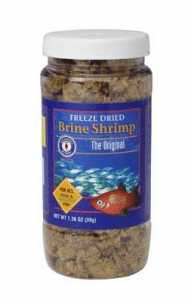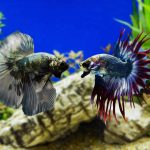Opportunistic fish in the wild feed on whatever is available to them to gain the nutrients they require – this could result in overfeeding your aquarium and polluting its waters.
Typically, it is wise to only feed your fish what they can finish devouring within five minutes; any excess will only create digestion issues or pollute your tank.
Contents
Frozen Foods
Frozen foods offer another option to diversify your fish’s diet, yet can often be more messy than pellet or flake food. Krill, brine shrimp and daphnia can all be found frozen as whole organisms while others combine multiple species such as clams and squid into blocks of freeze-dried food.
Most frozen food comes in cubes or larger blocks that you can break apart to feed to your fish. When doing so, make sure not to give more than they can consume in two minutes; otherwise it could cause digestive issues as well as contamination of aquarium water.
Some frozen food products are designed specifically to promote coloration in your fish, such as those containing essential minerals that help bettas, guppies and many other tropical fish maintain vibrant hues. Frozen bloodworms are popular choices among these color enhancers and come in regular, jumbo or mini sizes to suit the needs of different tank inhabitants.
Pellets or Flakes
There are numerous varieties of fish food on the market and they vary considerably; from marine fish food, tropical, cold water or herbivorous/carnivore diets; most are very easy to use and provide essential food staples for small fish species.
Flakes are one of the most popular choices of food for tropical fish and provide a convenient meal solution for smaller species, while being relatively affordable and widely available. Unfortunately, however, they also tend to degrade quickly into the water column; feeding larger species such as plecos or African Mbuna with just flakes could overfeed the tank quickly.
Specialty flakes on the market can mimic what certain fish would find in their natural environment, with ingredients such as krill, spirulina, chlorella and algae to enhance color or protein and fiber to strengthen fish strength.
Live Foods
Many fish enthusiasts enjoy feeding their aquatic friends live foods as an exciting and interactive feeding time experience. Rinsing should always take place to remove debris and avoid changing water acidity levels, with bloodworms, daphnia (water fleas) and brine shrimp popular choices among aquatic enthusiasts. It is even possible to cultivate freshwater plankton (infusoria) specifically created to feed small fry and newly hatched corals.
Larger species often prefer feeding mealworms, earthworms and crickets as easy-to-culture feed sources that are disease free; this will supplement their diet. Vegetables are also popular with tropical fish species that prefer herbivory such as cucumber slices, lettuce leaves and shelled garden peas – these may all make good choices! Any foods containing bread, crackers or processed meats could expand and clog your fish’s digestive tract and should never include wheat as one of its first ingredients as this food source would cause digestive tract problems in fish species that consume it as their diet.
Algae
Algae are photosynthetic eukaryotic organisms belonging to the kingdom Protista that thrive predominantly aquatic environments. Algae range in size from microscopic unicellular forms like Chlamydomonas, through multicellular forms like Ulva linita from Kitimat region, up to giant kelp that can grow up to 50 metres (161 feet).
Algae species obtain nutrients through photoautotrophy or heterotrophy, osmosis or by phagocytosis/phagotrophy.
Coral reef Symbiodinium coral can form free-floating colonies like Spirogyra or be attached to rocks or bottom of bodies of water as Rhodymenia red seaweed, while others form symbiotic relationships with lichen or even animals such as Symbiodinium coral.
Microorganisms spread primarily through their spores, similarly to plants; however, unlike land plants which use air and water transport for dispersion purposes, zooplanktons don’t possess structures like stomata and phloem that make their movement easy.




